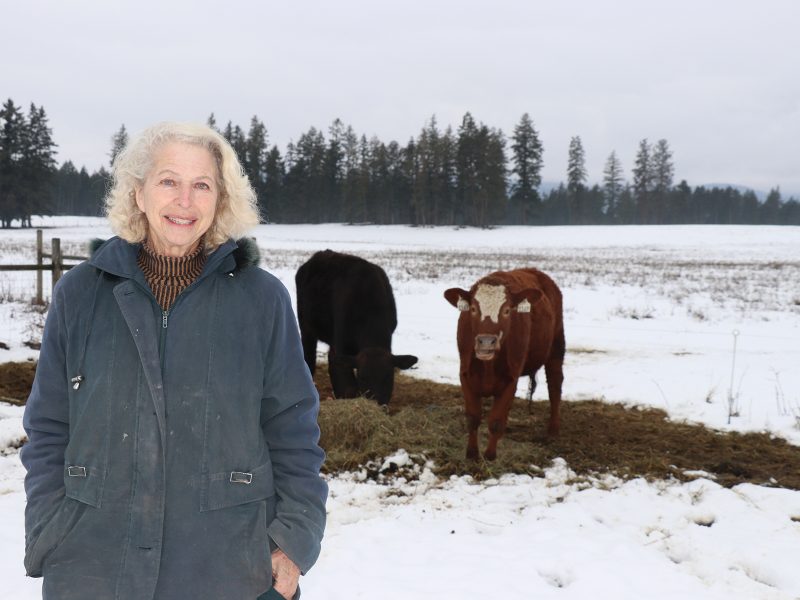SPALLUMCHEEN – Merritt’s loss is the North Okanagan’s gain as the Small-Scale Meat Producers Association shifts its focus from a Nicola Valley abattoir to a butcher hub based in Spallumcheen.
“We were able to pivot funds from the Nicola project to invest in the North Okanagan,” says SSMPA executive director Julia Smith. “This will be an actual building that will complement the on-going cooperation, collaboration and knowledge-sharing of our butcher hub network.”
An October meeting at the Silver Creek Community Hall south of Salmon Arm gave a thumbs-up to the new processing facility.
Emily Robertson of True North Farm in Armstrong says more processing capacity is a key to her expanding her operation. It’s been lacking since provincial meat licensing regulations were overhauled nearly 20 years ago.
“Much of the small-scale processing capacity was lost,” Robertson notes. “There has been very little replacement of that capacity.”
While her pastures can support more animals, she lacks a reliable way to process them without local services.
“I really support the SSMPA with establishing a butcher hub so that people who want to can kill on farm and have their meat hung and butchered at a place that is not 500 km away,” she says. “This is very much needed.”
A butcher hub fits with small-scale local processing, Robertson says.
“I like the way they have gone about doing this and integrating it with the farmgate licensing program,” she says. “They are building the knowledge of people who get involved with this which is really the way to go forward.”
Smith notes that recently opened Yankee Flats Meats is a big boost for the local farming community, offering slaughter and cut-and-wrap for pigs, lamb, and chickens as well as cut-and-wrap beef.
“But the bottleneck is in cut-and-wrap and value-added, and that’s what we hope to build,” Smith says.
SSMPA is looking to provide a smoker and top-level sausage-making equipment so producers can have their meat slaughtered on-farm, at Yankee Flats Meats or at Meadow Valley Meats in the Fraser Valley, and then use the butcher hub.
Robertson prefers to have her animals slaughtered on farm, but has struggled to find a reliable company to do the work. SSMPA has a solution for that.
“We have been able to use part of our Nicola project funding to purchase two more slaughter trailers,” Smith explains. “We have our original one up in the Peace and we have ordered a second one to be placed in the Kootenays and a third will go to the Spallumcheen and will be able to do on-farm kills in the area.”
The slaughter trailers will be able to hang, cool and transport the meat, Smith explains.
“We will have locker space for producers to hang their animals while they are accessing the butcher hub,” she says.
SSMPA is looking at a parcel of land in the Agricultural Land Reserve as part of Spallumcheen’s agri-industrial zone for the facility.
Spallumcheen will take the application to the Agricultural Land Commission and offer a long-term lease to SSMPA on approval.
“We are cautiously optimistic about getting approval fairly quickly,” Smith says.
Smith says the vision is for an 80×100 steel-frame building that will serve current needs and accommodate future growth.
“We are really hoping that down the road it will become a provincially inspected abattoir,” Smith says. “This is all part of our bigger picture view to open opportunities for growth in the industry.”
Staff will include trained, local butchers.
“We have a butcher that works with a small abattoir right now and they would be happy to move their operation, and we have a couple of other options,” Smith says. “Ideally, we want to lease it to an operator and we hope to be able to pay a decent wage for workers.
There are no plans for a storefront operation at this time.
“I don’t think the ALC would want that,” Smith says. “And most of the producers who will use it are doing their own direct marketing.”
Robertson captures the feelings of many small producers in the province.
“I don’t know how we’ve allowed ourselves to get into the situation where most of the meat we buy in our stores comes from another province,” she says. “The carbon footprint just from the transportation is horrific and the stress on the animals is huge.”


 BC control zones revoked
BC control zones revoked